Text

-----
“Men who hate women on Twitter are weird. I hate mushrooms but I don’t hunt down, correct, criticise, humiliate, harass then jack off to them”
- @Ahhmandah
304 notes
·
View notes
Text
Week 10: Unveiling the Impact of Online Harassment: Impeding Women's Digital Participation and Citizenship
Online harassment is offensive behavior directed at others through technology channels, such as the internet or text messaging, which can cause harm unintentionally or otherwise (Haslop et al., 2021, p. 1420). Female and transgender individuals are more likely to face online harassment than men Haslop et al., 2021, p. 1413). Harassment towards feminists and female public figures often originates from the manosphere, an online network of pickup artists, men's rights activists, anti-feminists, and fringe groups (Marwick & Caplan, 2018). It is often coordinated and organized, rather than just individual actions (Marwick & Caplan, 2018). For example, female journalist Siobhan Fenton was abused online when she appeared in a video of The Independent on X, receiving hundreds of negative comments, and a blogger on Tumblr who was trolled by a male from the manosphere for sharing information about safe abortion.
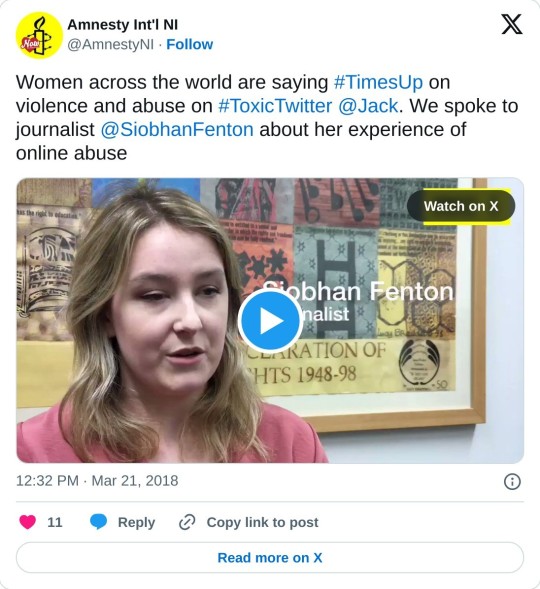

Figure 1. An anti-abortion comment from the manosphere aimed at a feminist female blogger.
Online harassment is pervasive in digital spaces, leading some young women to tolerate offensive and abusive communications (Smith, 2018). Young women perceive such communications to be relatively acceptable and the 'norm' (Haslop et al., 2021, p. 1413). They often use silencing strategies like blocking, reporting, and limiting participation, self-censorship as means of protection (Haslop et al., 2021, p. 1413). In the case of Siobhan Fenton, she silently suffered without reporting it to X because she knew this often happened to her colleagues and reporting was ineffective. Online harassment hinders women's online participation and citizenship, leading to gendered digital divides (Vitis & Gilmour, 2016, p. 337). It negatively impacts victims' motivation to use and engage with digitized spaces, leading to women excluding themselves from online spaces (Haslop et al., 2021, p. 1412).
Regarding digital citizenship, which allows internet users to participate without fear (Thompson, 2023), is threatened by online harassment (Vitis & Gilmour, 2016, p. 337). Online harassment also leads to offline violence and contributes to mental health issues, as it makes women feel unsafe in online spaces (Vitis & Gilmour, 2016, p. 337). Kelly Sue DeConnick, a comics writer, criticized sexism in the industry, highlighting the potential harm of online harassment on her family due to anxiety or fear of being blamed for speaking up (Amnesty International, 2018). Therefore, addressing online harassment is crucial for promoting digital citizenship and reducing gender disparities.

Figure 2. Kelly Sue DeConnick.
What can be done?
In Vietnam, the Law on Cyber Security provides protection against cyberbullying and harmful online content, with ministries responsible for ensuring online safety and removing inappropriate material (Vietnam Law and Legal Forum, 2023). Additionally, some women employ humor and social media platforms as a means of engaging, resisting, and responding to harassment (Vitis & Gilmour, 2016). Projects like Instagranniepants (Figure 3) and Gensler's critical witnessing utilize satire and shame, aiming to give harassers a taste of their own medicine through unflattering portraits (Vitis & Gilmour, 2016).
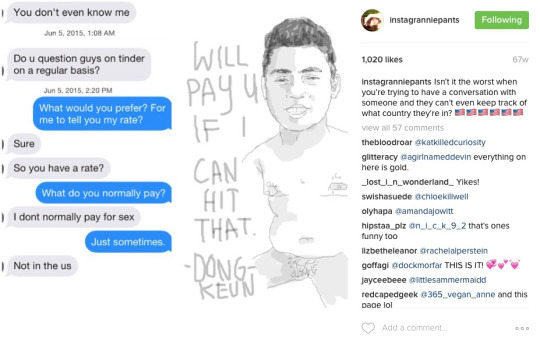
Figure 3. Instagranniepants project.
References
Amnesty International. (2018, March 20). Toxic Twitter - The Psychological Harms of Violence and Abuse Against Women Online. Amnesty International. https://www.amnesty.org/en/latest/news/2018/03/online-violence-against-women-chapter-6-6/
Haslop, C., O’Rourke, F., & Southern, R. (2021). #NoSnowflakes: The toleration of harassment and an emergent gender-related digital divide, in a UK student online culture. Convergence: The International Journal of Research into New Media Technologies, 27(5), 1418–1438. https://doi.org/10.1177/1354856521989270
Marwick, A. E., & Caplan, R. (2018). Drinking male tears: language, the manosphere, and networked harassment. Feminist Media Studies, 18(4), 543–559. https://doi.org/10.1080/14680777.2018.1450568
Thompson, J. D. (2023, March 17). New journalism research will help mitigate the harms of online hostility. Freilich Project for the Study of Bigotry. https://freilich.anu.edu.au/news-events/blog/new-journalism-research-will-help-mitigate-harms-online-hostility
Vietnam Law and Legal forum. (2023). Protection of women and juveniles from cyberspace violence in Vietnam today. Vietnamlawmagazine.vn. https://vietnamlawmagazine.vn/protection-of-women-and-juveniles-from-cyberspace-violence-in-vietnam-today-71137.html
Vitis, L., & Gilmour, F. (2016). Dick pics on blast: A woman’s resistance to online sexual harassment using humour, art and Instagram. Crime, Media, Culture: An International Journal, 13(3), 335–355. https://doi.org/10.1177/1741659016652445
#mda20009#online harassment#online abuse#protect women#Instagranniepants#manosphere#digital citizenship#safeonline
0 notes
Text
Week 9: Revolutionizing Game Content: Live Streaming, Stream Communities, and Inclusivity
Live streaming has revolutionized the way game content is broadcasted, captivating millions of viewers in esports tournaments and drawing large audiences for variety streamers (Taylor, 2018, p. 4). With the continuous development of streaming platforms and broadcasting features, live streaming has transformed into a 24/7 phenomenon, generating and consuming hours of gaming content daily (Taylor, 2018, p. 4). This networked broadcast medium integrates interactive elements, such as chat windows, to engage viewers and create a unique experience (Taylor, 2018, p. 6). As the game community embraces live streaming, it serves as a bridge connecting players and audiences, fostering social connections and transcending traditional entertainment boundaries (Hjorth et al., 2020, p. 32).
Live Streaming and the Game Community
Live streaming platforms like Twitch and YouTube have become essential tools for the game community to engage and involve audiences. Minecraft streamers like Banana utilize these platforms to share their gameplay sessions and showcase the virtual worlds they have created. By guiding viewers through their digital environments, they provide insights into their current activities and future aspirations (Hjorth et al., 2020, p. 32). These live streaming communities act as bridges, facilitating conversations not only within specific gaming communities but also extending beyond them (Hjorth et al., 2020, p. 32).
youtube
The Power of Stream Communities
Stream communities driven by the personalities of streamers have a profound impact, extending far beyond gameplay. These communities attract viewers who develop deep emotional connections and perceive the streamer and fellow viewers as friends (Taylor, 2018, p. 6) (Hamilton et al., 2014, p. 1319). A prime example is Do Mixi, a popular Vietnamese streamer who has attracted a loyal fan base with a fan community on Facebook reaching 3 million through engaging interactions and humorous commentary. Fans of Do Mixi's streams have formed strong emotional bonds and proudly identify themselves as part of the "Bo Toc Mixi" community. The chat window in livestreaming (Figure 1), Facebook group, and Discord server associated with Do Mixi's streams serve as vibrant social spaces where viewers actively interact, share memes (Figure 2), and even organize real-world meet-ups and events. These stream communities foster a sense of belonging and camaraderie among viewers, transforming the streaming experience into a dynamic and interactive social phenomenon (Hjorth et al., 2020, p. 31).

Figure 1.

Figure 2.
Cultural Intersection and Inclusivity
Game live streaming goes beyond entertainment, intersecting with significant cultural and socio-political issues (Taylor, 2018, p. 14). Communities like "Black Girl Gamers" on Twitch exemplify the platform's potential to celebrate and promote underrepresented voices within the gaming industry (Conditt, 2018). By providing a platform for Black women gamers to showcase their skills and fostering an inclusive space, live streaming addresses contemporary concerns of representation, diversity, and inclusion (Conditt, 2018). These streamer channels become dynamic sites of cultural production, reflecting the evolving landscape of gaming and leisure.
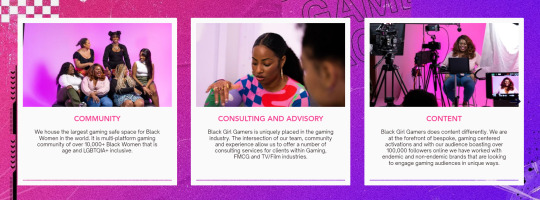
In conclusion, live streaming has revolutionized the consumption of game content, creating a networked broadcast medium that transcends traditional entertainment boundaries. Stream communities, driven by the personalities of streamers, foster emotional connections and friendships among viewers, while also addressing cultural and socio-political issues. This platform promotes inclusivity, representation, and diverse voices in the gaming industry, underscoring the importance of comprehending the political and civic dimensions in the digital era.
References
Conditt, J. (2018). Striving to be seen: Black Girl Gamers on Twitch. Engadget. https://www.engadget.com/2018-08-15-black-girl-gamers-twitch-partner-communities.html
Hamilton, W., Garretson, O., & Kerne, A. (2014). Streaming on Twitch: Fostering participatory communities of play within live mixed media. Streaming on Twitch: Fostering Participatory Communities of Play within Live Mixed Media, 1315–1324. https://doi.org/10.1145/2556288.2557048
Hjorth, L., Richardson, I., Davies, H., & Balmford, W. (2020). Exploring Play. Exploring Minecraft, 27–47. https://doi.org/10.1007/978-3-030-59908-9_2
Keogh, B. (2021). The Melbourne indie game scenes: Value regimes in localized game development (P. Ruffino, Ed.). Eprints.qut.edu.au; Routledge. https://eprints.qut.edu.au/227028/
Taylor, T. L. (2018). Watch Me Play. https://doi.org/10.2307/j.ctvc77jqw
#mda20009#gameculture#gaming#video games#livestream#female gamer#black girl gamer#twitch streamer#small streamer#minecraft#game community
0 notes
Text
Week 8: Beauty Filters: Unveiling the Impact on Beauty Standards and Self-Perception
The evolution of AR masks and filters has been remarkable, with over 600 million people utilizing filters on Facebook or Instagram, as reported by Meta (Well, 2023). Snapchat pioneered face filters in 2015, introducing augmented reality into daily routines and enabling users to enhance their appearance, alter facial features, or virtually accessorize (Barker, 2020, p. 208) (as Figure 1). Even cosmetic companies have tapped into Snapchat's platform to promote their products, with Ulta Beauty introducing shoppable Snapchat AR lenses. This practice of 'digital adornment' has opened up new avenues for self-expression and interaction in the digital realm (Barker, 2020, p. 208)

Figure 1. Kendall Jenner uses Snapchat's beauty filter.
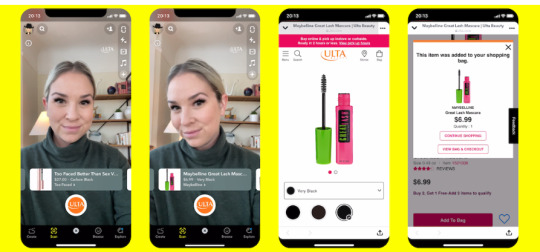
Figure 2. Ulta Beauty's Snapchat AR lenses.
However, beauty apps have contributed to the creation of unattainable beauty standards in our image-saturated culture (Coy-Dibley, 2016, p. 3). The 'pretty' filter, in particular, presents an idealized image devoid of flaws and perpetuates the beauty standard pushed by the beauty industry (Barker, 2020, p. 208). These filters can unexpectedly alter facial features, conforming to stereotypical feminine ideals by enlarging eyes and shrinking other proportions, with people of color experiencing unnatural skin-lightening effects (Barker, 2020, p. 213). Certain filters, like animal-themed ones, can unexpectedly alter facial features like enlarging eyes and shrinking other proportions (Barker, 2020, p. 213). Such filters evoke complex emotions about one's natural appearance and can lead to conflicts and discontent among users. For example, Allegra Clark's tweet shared her upset with the Snapchat filter. Some scholars even point out that unrealistic desires, such as flawless skin and large eyes, stem from a narrow Western beauty standard that excludes diversity (Hunt, 2019), highlighting the inequalities (Barker, 2020, p. 209).

Figure 3. Filter changes facial features in accordance with beauty standards.

Figure 4. Allegra Clark's tweet.
The use of beauty filters has also given rise to a phenomenon known as "selfie dysmorphia," where individuals seek treatments to alter their features to resemble their filtered appearances (Coy-Dibley, 2016, p. 2). This extends to "Snapchat dysmorphia," associated with body dysmorphic disorder, as users desire procedures to emulate their digital images (Hunt, 2019). Such as in the interview video below, Dr. Tijion Esho, in a video interview, highlights a case where a patient sought eye surgery to match the size depicted in a filter, only to find it impossible to achieve. This phenomenon contributes to social body dysmorphia, driven by influential beauty industries and cultural norms (Coy-Dibley, 2016, p. 2). Women face competition in media and digital representations, leading to social body dysmorphia, as beauty industries objectify and sexualize female bodies, perpetuating narrow femininity and societal pressure to conform to beauty standards (Coy-Dibley, 2016, p. 5).
youtube
In conclusion, while beauty filters offer new avenues for self-expression and interaction, they also perpetuate unattainable beauty standards, contribute to social body dysmorphia, and lead to the emergence of selfie dysmorphia. Recognizing these effects is crucial in fostering healthier digital environments and promoting diverse and inclusive beauty standards.
References
Barker, J. (2020). Making-up on mobile: The pretty filters and ugly implications of Snapchat. Fashion, Style & Popular Culture, 7(2), 207–221. https://doi.org/10.1386/fspc_00015_1
Coy-Dibley, I. (2016). “Digitized Dysmorphia” of the female body: the re/disfigurement of the image. Palgrave Communications, 2(1). https://doi.org/10.1057/palcomms.2016.40
Hunt, E. (2019, January 23). Faking it: How Selfie Dysmorphia Is Driving People to Seek Surgery. The Guardian; The Guardian. https://www.theguardian.com/lifeandstyle/2019/jan/23/faking-it-how-selfie-dysmorphia-is-driving-people-to-seek-surgery
The Young Turks. (2016). Do Snapchat Beauty Filters Make You Look Better, Or Whiter? Www.youtube.com. https://www.youtube.com/watch?v=Qx_vQs2ioeo
Well, T. (2023). The Hidden Danger of Online Beauty Filters | Psychology Today Canada. Www.psychologytoday.com. https://www.psychologytoday.com/ca/blog/the-clarity/202303/can-beauty-filters-damage-your-self-esteem#:~:text=In%20addition%2C%20Meta%20reports%20that
#mda20009#beauty filters#beauty standards#digitaldysmorphia#snapchat#cosmetic surgery#diversity#stereotypes
0 notes
Text
Week 7: The Hyper-Sexualization and Aestheticization of Female Bodies -Influencers, Social Media, and the Negative Impact of Beauty Standards
The beauty and sex industries in Western society continue to promote the hyper-sexualization and aestheticization of female bodies (Coy-Dibley, 2016). The rise of "influencer commerce" has brought significant changes to how online content is created and consumed (Drenten et al., 2019, p. 42). However, social media algorithms often prioritize high-value users, leading to limited visibility for others (Carah & Dobson, 2016, p. 3). In pursuit of a large following and monetization, particularly women influencers conform to societal standards of unattainable and specific feminine aesthetics (Coy-Dibley, 2016).
On social media, the representation of women is closely tied to their bodies, influenced by societal norms and categories (Drenten et al., 2019, p. 51). The beauty and sex industries have commodified certain femininities and aesthetics, leading women to employ strategies like fashion choices and beauty practices to present themselves in highly sexualized ways (Drenten et al., 2019, p. 51). Influencers often emphasize specific body parts, wear revealing clothing, and engage in gestures that hint at undressing, contributing to a recognizable "porn chic" aesthetic (Drenten et al., 2019, p. 51). For example, Kim Kardashian and Kylie Jenner. As Figure 1 shows, to conform to societal standards of attractiveness and femininity, they strategically choose outfits that accentuate certain body parts, such as wearing form-fitting clothing, bikini to emphasize curves or revealing clothing to highlight their physical attributes.

Figure 1. Kim Kardashian and Kylie Jenner's Instagram post.
The pursuit of beauty standards negatively impacts female bodies, leading to cosmetic-seeking behavior and body dissatisfaction. Social comparison theory explains how women compare themselves to idealized bodies, resulting in insecurity and body-image issues (Coy-Dibley, 2016). This can contribute to the development of Body Dysmorphic Disorder (BDD), where individuals become excessively concerned about perceived flaws in their appearance (Nicewicz & Boutrouille, 2022). Industries and media perpetuate the belief that women's bodies are never good enough, fueling the desire for constant improvement (Dorfman et al., 2017). Social media platforms like Instagram amplify these pressures, normalizing cosmetic interventions and creating unrealistic expectations (Rodner et al., 2021). For example, the plastic surgery craze dubbed the "Dash Effect" saw a surge in inquiries for lip fillers after Kylie Jenner admitted to having the procedure (Olya , 2015) As Figure 2 shows, many young women get lip filler injections to get Kylie lips. The Kardashian unrealistic beauty standard contributes to an increase in cosmetic-seeking behavior as inspirations, with a significant percentage of patients seeking aesthetic surgery to enhance their appearance.
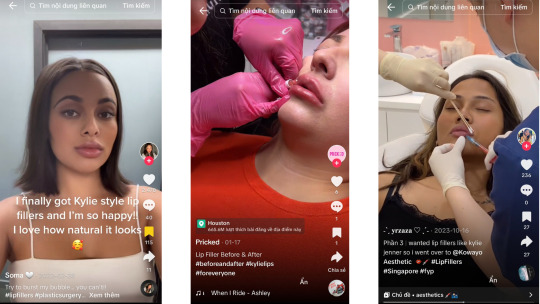
Figure 2. Young women get lip filler injections to get #Kylielips.
In light of these findings, it is critical to challenge the beauty and sex industries' influence on female bodies. For example, The Dove Self-esteem project is challenging the beauty standard. By promoting diverse representations, body positivity, and healthy perceptions of beauty, digital citizen can work toward a society that values and embraces each individual's uniqueness and inherent worth, free of the negative effects of unrealistic beauty standards.
youtube
References
Carah, N., & Dobson, A. (2016). Algorithmic hotness: Young women’s “promotion” and “reconnaissance” work via social media body images. Social Media + Society, 2(4), 1–10. https://doi.org/10.1177/2056305116672885
Coy-Dibley, I. (2016). “Digitized Dysmorphia” of the female body: the re/disfigurement of the image. Palgrave Communications, 2(1). https://doi.org/10.1057/palcomms.2016.40
Dorfman, R. G., Vaca, E. E., Mahmood, E., Fine, N. A., & Schierle, C. F. (2017). Plastic Surgery-Related Hashtag Utilization on Instagram: Implications for Education and Marketing. Aesthetic Surgery Journal, 38(3), 332–338. https://doi.org/10.1093/asj/sjx120
Drenten, J., Gurrieri, L., & Tyler, M. (2019). Sexualized labour in digital culture: Instagram influencers, porn chic and the monetization of attention. Gender, Work & Organization, 27(1). https://doi.org/10.1111/gwao.12354
Duffy, B. E., & Meisner, C. (2022). Platform governance at the margins: Social media creators’ experiences with algorithmic (in)visibility. Media, Culture & Society, 45(2), 016344372211119. https://doi.org/10.1177/01634437221111923
Nicewicz, H. R., & Boutrouille, J. F. (2022, September 28). Body Dysmorphic Disorder (BDD, Dysmorphobia, Dysmorphic Syndrome). PubMed; StatPearls Publishing. https://www.ncbi.nlm.nih.gov/books/NBK555901/
Olya , G. (2015, November 24). The “Dash Effect”: Kardashian-Inspired Plastic Surgery Procedures on the Rise, Say Experts. PEOPLE.com. https://people.com/health/the-dash-effect-kardashian-inspired-plastic-surgery-procedures-on-the-rise-say-experts/
Rodner, V., Goode, A., & Burns, Z. (2021). “Is it all just lip service?”: on Instagram and the normalisation of the cosmetic servicescape. Journal of Services Marketing, ahead-of-print(ahead-of-print). https://doi.org/10.1108/jsm-12-2020-0506
#mda20009#body modification#body image#cosmetic surgery#body dysmorphia#kylie jenner#kim kardashian#Youtube
0 notes
Text
Week 6: From Fast to Slow Fashion, Influencers Lead the Way and the trend of "Deinfluencing"
The fast fashion model has revolutionized the fashion industry by prioritizing cost reduction and production speed. However, it has also resulted in increased environmental impact and waste generation (Domingos et al., 2022, p.2). According to the UN Environment Programme, fast fashion is the second-largest consumer of water and contributes to 10% of global carbon emissions, yet consumer concerns are often overlooked (Nijman, 2019).
The "Slow Fashion" movement aims to combat over-consumption and waste (Domingos et al., 2022, p. 3) by encouraging consumers to buy products that contribute to environmental protection (Chi et al., 2021, p. 110). However, research suggests that interest in sustainable fashion does not always lead to behavioral changes (Brewer, 2019, p. 7). Consumers who believe their slow fashion choices contribute to environmental protection are more likely to support and purchase these products (Chi et al., 2021, p. 110). Greater environmental knowledge may also lead to more favorable attitudes towards slow fashion consumption, encouraging positive environmental impacts and addressing the hidden costs of cheap fashion (Brewer, 2019, p. 7).
Social media significantly influences consumer behavior towards sustainable and ethical fashion choices (Jacobson & Harrison, 2021, p. 153). Influencers on social media, particularly those who are relatable, have a significant impact on purchasing decisions. Awareness of sustainability and influencer persuasion can positively influence purchasing choices (Jacobson & Harrison, 2021, p. 153). Sustainable lifestyle influencers engage with the public by making their choices relatable, fostering communities, and responding to sustainability-related questions (Jacobson & Harrison, 2021, p. 153). TikToker Lily (@imperfectidealist) promotes sustainable fashion by sharing content about repairing old clothes, showcasing eco-brands, and responding to sustainability-related questions by short videos. Another example is Big Sister Swap, has been gaining attention through YouTubers and TikTokers sharing haul swaps. These engagement with the audience demonstrates how digital citizenship can raise awareness and foster responsible online marketplaces.

Figure 1. TikToker Lily (@imperfectidealist) promotes sustainable fashion.
youtube

Figure 2. TikToker videos about trying on and hauling clothes after swapping by Big Sister Swap.
However, overconsumption continues to surge, as evident from the popularity of hashtags like #sheinhaul on TikTok, boasting over 800K posts. However, a new trend called "deinfluencing" has emerged, particularly within the fashion industry (Mayer, 2023). Deinfluencers actively confront the negative environmental and human rights effects of fast fashion (Johnson, 2023). This movement strikes a chord with social media users who crave authenticity and transparency from their online role models (Johnson, 2023). For instance, TikToker Christina (@christina.mychas) underwent a transformation from shopaholic to minimalist, sharing content that emphasizes avoiding waste and the disposability of fashion trends once they fade away.

Figure 3. TikToker Christina (@christina.mychas) shares fashion items she does not buy to avoid waste as a deinfluencer.
In conclusion, the fashion industry is undergoing a significant transformation from fast fashion to slow, sustainable practices. Influencers on social media play a vital role in shaping consumer behavior towards sustainable fashion choices. While challenges like overconsumption persist, the emerging trend of "deinfluencing" offers hope by encouraging authenticity and promoting conscious consumption. A collective effort is needed to drive systemic change and create a fashion industry that prioritizes environmental protection and social responsibility.
References
Brewer, M. K. (2019). Slow Fashion in a Fast Fashion World: Promoting Sustainability and Responsibility. Laws, 8(4), 24. MDPI. https://doi.org/10.3390/laws8040024
Chi, T., Gerard, J., Yu, Y., & Wang, Y. (2021). A study of U.S. consumers’ intention to purchase slow fashion apparel: understanding the key determinants. International Journal of Fashion Design, Technology and Education, 14(1), 101–112. https://doi.org/10.1080/17543266.2021.1872714
Domingos, M., Vale, V. T., & Faria, S. (2022). Slow Fashion Consumer Behavior: a Literature Review. Sustainability, 14(5), 2860. https://doi.org/10.3390/su14052860
Jacobson, J., & Harrison, B. (2021). Sustainable fashion social media influencers and content creation calibration. International Journal of Advertising, 41(1), 1–28. https://doi.org/10.1080/02650487.2021.2000125
Johnson, A. (2023). Rise Of The Deinfluencer: Growing Social-Media Movement Challenges Influencers And Consumerism. Forbes. https://www.forbes.com/sites/ariannajohnson/2023/03/08/rise-of-the-deinfluencer-growing-social-media-movement-challenges-influencers-and-consumerism/?sh=17274d974a44
#mda20009
#slow fashion#fast fashion#ecofriendly#sustainability#sustainable fashion#overconsumption#deinfluencing#influencer
0 notes
Text
Week 5: Digital Citizenship and Political Engagement: The Power and Pitfalls of Hashtag Movements in the #MeToo Era.
Digital media has revolutionized the public sphere, offering digital citizens unprecedented opportunities to engage in politics through social media and the internet (Vromen, 2016, p. 3). This transformation has given rise to the concept of digital citizenship, which emphasizes personalized and ad hoc participation, enabling individuals to shape their political engagement (Vromen, 2016, p. 3). In today's digital era, social media platforms play a vital role in promoting participatory democracy and civic engagement (Choi & Cristol, 2021, p. 365). They serve as powerful tools for electoral campaigns, protests, and the formation of voluntary groups, fostering inclusive civic behavior and increasing participation among younger and disengaged populations (Theocharis et al., 2022, p. 788).
Hashtags, represented by the "#" symbols followed by keywords have become significant in shaping online discourse. They serve as discursive markers, facilitating the spread of awareness and expressing support for social movements (Kim & Lee, 2022). A prominent example of digital citizenship and political engagement is the #MeToo movement on Twitter. With the goal of raising awareness about sexual harassment and assault, the movement encourages survivors to share their experiences using the hashtag #MeToo. By transcending traditional institutions, the #MeToo movement enables dialogue between individuals, corporations, and transnational policy forums, particularly focusing on issues related to gender inequality (Choi & Cristol, 2021, p. 365). In 2017, Twitter confirmed #MeToo reaches 85 countries with 1.7M tweets (Park, 2017).
Social media platforms, Twitter, serve as vital spaces for the #MeToo movement, providing fast, accessible, and diverse means of communication (Theocharis et al., 2022, p. 793). Digital citizens engage politically by creating tweets, retweeting to show support for survivors, and actively participating in the online conversation with the hashtag. The use of hashtags allows individuals to express their views, contribute to collective discussions, raise awareness, and foster the growth of the #MeToo community. The movement heavily relies on the #MeToo hashtag as a tool for organizing and mobilizing supporters.
However, as Kim and Lee (2022) highlight, conflicting interpretations and hashtag hijacking can occur. The #MeToo movement, initially aimed at promoting awareness of sexual harassment, has been misused in certain instances, leading to unfair judgments and harm to innocent individuals without proper consideration of due process or fair trials, as seen in the Amber Heard versus Johnny Depp case (Spectator Australia, 2022). This underscores the vulnerability of hashtag movements, particularly in controversial issues.
In conclusion, digital media has transformed the public sphere, providing digital citizens with unprecedented opportunities for political engagement. The #MeToo movement exemplifies the power of digital citizenship and political activism on social media platforms. However, the potential for contrasting interpretations and misuse of hashtags highlights the need for critical engagement and responsible use of digital tools in shaping public discourse.

0 notes
Text
Week 4: The Evolution of Reality TV: Amplified Visibility, Social Media, and Political Discourse in the Case of 'Rap Viet.
Reality TV has undergone a significant transformation, evolving into a realm of exaggerated visibility that combines intense emotions and boundary-pushing behavior within a controlled TV environment (Kavka, 2018, p. 7). This transformation has been further propelled by the rise of social media, which has expanded the reach and audience of reality TV shows. In this new landscape, social media platforms have become crucial for reality TV participants to establish an online presence, extending their fame and income potential (Deller, 2019, p. 162). They can share authentic experiences, promote brands, and act as promotional vehicles for upcoming projects, leveraging their online platforms (Deller, 2019, p. 163). This convergence of television and new media has transformed reality TV into a network of interconnected narratives, blurring the lines between real and performed identities, and providing viewers with an interactive and engaging experience beyond traditional TV broadcasts (Arcy, 2018, p. 488). "Rap Viet" serves as an exemplary case of the transformative power of reality TV in the context of rap music. This popular Vietnamese reality TV show focuses on rap battles and showcases the talent of Vietnamese rappers. Notably, participants like Phap Kieu, suboi, etc. utilize social media to livestream, share behind-the-scenes videos, and even some dramas in "Rap Viet" to generate more awareness and engagement. It utilizes social media platforms to extend its reach and engage with a wider audience.
Additionally, reality TV acts as a catalyst for public discussions on politics and societal issues (Graham & Hajru, 2011, p. 29). Web 2.0 technologies and participatory culture have facilitated reality show chat on various online platforms, fostering political talk and public discourse (Deller, 2019, p. 153; Graham & Hajru, 2011, p. 29). "Rap Viet" often addresses social issues, sparking debates on politics, inequality, and youth culture. For instance, MC Tran Thanh's statement about feminism ignited discussions on gender equality and feminism in Vietnamese society, with diverse opinions and fragmentations within the public sphere (Graham & Hajru, 2011, p. 19). The statement received a lot of criticism from communities fighting for women's rights. An analysis of up to 2,100 likes by the Vietnam Organization for Promoting Gender Equality, VOGE, said that Tran Thanh is underestimating the efforts of those who are promoting gender equality for women (Nguyen Hoai, 2020). These discussions showcase how reality TV serves as a platform for citizens to engage in political discourse, bridge knowledge and experiences, and contribute to wider societal debates (Graham & Hajru, 2011, p. 29).
In conclusion, the convergence of television and social media has transformed reality TV into a realm of exaggerated visibility, extending beyond traditional TV broadcasts. "Rap Viet" exemplifies this transformation, leveraging social media to engage a broader audience and redefine the rap scene in Vietnam. Moreover, reality TV fuels public discussions on politics and societal issues, serving as a catalyst for political talk and contributing to the wider political discourse within the public sphere.
References
Arcy, J. (2018). The digital money shot: Twitter wars, The Real Housewives, and transmedia storytelling. Celebrity Studies, 9(4), 487–502. https://doi.org/10.1080/19392397.2018.1508951
Deller, R. A. (2019). Reality Television in an Age of Social Media. https://doi.org/10.1108/978-1-83909-021-920191007
Graham, T., & Hajru, A. (2011). Reality TV as a trigger of everyday political talk in the net-based public sphere. European Journal of Communication, 26(1), 18–32. https://doi.org/10.1177/0267323110394858
Kavka, M. (2018). Reality TV: its contents and discontents. Critical Quarterly, 60(4), 5–18. https://doi.org/10.1111/criq.12442
Nguyen Hoai, M. (2020, November 16). Tóm Lại Là: Quyền nữ, sao cứ phải “đòi”? Vietcetera. https://vietcetera.com/vn/tom-lai-la-quyen-nu-sao-cu-phai-doi
youtube
youtube
0 notes
Text
Week 3: Tumblr: Digital Community and its Limitations to Become an Ideal Public Sphere.
“Tumblr is whatever you want it to be”
Tumblr is a platform that merges traditional weblogs and social networking sites to create a diverse online space for users to share content (Reif et al., 2022, p. 6). It emphasizes individuality and niche interests, fostering a sense of belonging. Tumblr's platform affordances, particularly hashtags, allow users to form communities and interact with content, connecting with like-minded people (Reif et al., 2022, p. 7). The visibility of posts within hashtags is independent of followers, participation, or reactions, allowing a wider range of voices to be heard (Keller, 2019, p. 7). Tumblr is anonymous, making owners difficult to identify, and discourages negative reactions and trolling by hiding specific reactions behind the summary (Reif et al., 2022, p. 7).
Regarding Tumblr functions as a digital community, Keller (2019) research has highlighted Tumblr's role as a digital community, particularly for feminist discussions and activism. The platform provides a safe space for young girls to explore feminist ideas and engage in meaningful conversations (Keller, 2019, p. 8). This platform offers unique social privacy, allowing users to curate personal blogs and connect with like-minded individuals without revealing their identity (Keller, 2019, p. 8). Tumblr is a feminist-friendly space where sophisticated discussions about intersectionality, patriarchy, and frequent protest occur. Young girls find it a safer environment for feminist activism compared to other social media platforms (Keller, 2019, p. 8). Tumblr remains a vibrant digital community that continues to shape and redefine online culture.
Tumblr exhibits some characteristics of the public sphere by Habermas (1991) and Kruse et al. (2018), such as its free access, lack of content moderated based on interactions or celebrity endorsements which equal participation, and policies supporting free speech. However, it still spreads hate and online harassment, exposing feminist girls and women, particularly those from marginalized communities (as the first image show a case of abortion rights on Tumblr). This limits the freedom and safety for users to use the site for meaningful ideas exchange (Kruse et al., 2018, p. 65). Additionally, platform affordances only connect like-minded people, limiting different perspectives that cannot become a public sphere (Kruse et al., 2018, p. 77). Tumblr shares some characteristics with the public sphere, but it also has limitations that prevent it from becoming an ideal public sphere.
References
Habermas, J. (1991). The Structural Transformation of the Public Sphere. MIT Press. https://mitpress.mit.edu/9780262581080/the-structural-transformation-of-the-public-sphere/
Hillman, S., Procyk, J., & Neustaedter, C. (2014). Tumblr fandoms, community & culture. Proceedings of the Companion Publication of the 17th ACM Conference on Computer Supported Cooperative Work & Social Computing - CSCW Companion ’14. https://doi.org/10.1145/2556420.2557634
Keller, J. (2019). “Oh, She’s a Tumblr Feminist”: Exploring the Platform Vernacular of Girls’ Social Media Feminisms. Social Media + Society, 5(3), 1–11. https://doi.org/10.1177/2056305119867442
Kruse, L. M., Norris, D. R., & Flinchum, J. R. (2018). Social Media as a Public Sphere? Politics on Social Media. The Sociological Quarterly, 59(1), 62–84. https://doi.org/10.1080/00380253.2017.1383143
Reif, A., Miller, I., & Taddicken, M. (2022). “Love the Skin You‘re In”: An Analysis of Women’s Self-Presentation and User Reactions to Selfies Using the Tumblr Hashtag #bodypositive. Mass Communication and Society. https://doi.org/10.1080/15205436.2022.2138442
Tumblr. (n.d.). About Tumblr. Tumblr. Retrieved February 2024, from https://about.tumblr.com/


1 note
·
View note